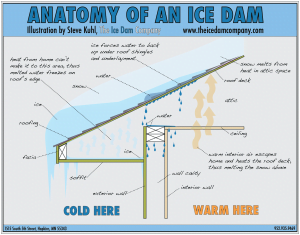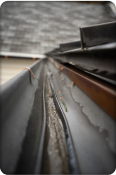Heated Gutter
Using Heat Tape To Create A Heated Gutter
A heated gutter system is made up of a gutter and self-regulating heat tape threaded into your gutters and downspouts under a gutter guard system. The heat tape warms the gutter during winter weather to prevent the problems caused by snow and ice build-up.
Talk to us about Heated Gutters Today!
Why Heated Gutters?
If you are a homeowner in a colder climate and have to deal with snow and ice on your roof, there is always that nagging concern about ice dams causing a leak. The resulting water damage can become a nightmare for you and your home.
During harsh winters, homeowners can experience unprecedented damage due to ice damming leading to greater repair costs.
In addition, the buildup of large icicles dangling on the roof’s edge above walkways and driveways can be a hazard during the winter months. In extreme cases, the added weight of accumulated snow and ice can also cause gutters to pull away from your home, cracking, or falling down completely.
One of the best ways to add peace of mind and prevent ice dams is to have heat tape added to your gutters. Heat tape is a cable that heats up enough to melt snow and ice, but not enough to cause damage to your home.
What About Heated Tape on the Roof?
Unlike roof heat cable that lies on top, and snaked along the roof’s edge, we install heated gutter cables —sometimes called heat tape— inside the gutters just under a gutter guard system and inside the downspouts.
This combination of heated gutters and heated gutter guards prevents most of the problems that can occur when using roof heat tape / heat cable.
So, is installing heat tape really worth it? Well, the truth is, it’s only worth it if done correctly.
There are several methods companies use to install heat cables, the most popular being the zigzag pattern. When installed, they make a triangle pattern on the first 3ft of the roof. It is then lined inside of the gutter and downspout with the cable.
Installing Heat Tape on the roof may melt the snow and ice on the roof but does not prevent ice damming from occurring in and on your gutters. The Ice can still clog your gutters and build up because the water flow is restricted.
Additionally, this method was proven to cause more damage to the roof, overtime, than having no cable at all and may violate your roof’s warranty.
Heat Tape works better inside a Gutter System
We use Weather-Ready heat tape that is only installed on the inside of the gutters and downspouts. This way the shingles aren’t affected, the heat tape is protected, and you’re only heating the gutters. This method not only works great, but it looks great. With the gutter guard on, it traps all the heat from the heat tape inside, allowing the whole gutter system to stay warm. Therefore, when snow on the roof starts to melt, it will hit a warm gutter guard and a warm gutter, preventing ice and snow from building up in your gutter system. This allows your gutters to only deal with water, not ice. It is essential that the heat cable be turned on just prior to snowfall for optimal results. Learn more about how heat cables work.
Heated cable for your gutters is a necessity in areas with very harsh winters, and heavy snowfall —helping to prevent the formation of ice dams and water from entering your home.
Snow Guards
Not to be confused with Gutter Guards; Snow Guards are another useful addition for roofs in snowy climates. Snow Guards are designed to prevent snow or ice from causing an avalanche off the roof which could cause it to fall onto landscaping or pedestrians below.
Ice Dams
The most common cause of ice dams is uneven or inadequate roof insulation or other causes of temperature fluctuations that allow the snow to melt and run down the roof —refreezing when it hits the colder part of the roof over the eaves. Ice builds up at the roof’s edge or gutters, trapping additional ice and water above it which begins to back up under the shingles above —allowing water to enter your attic, ceilings, and interior walls. Water damage in your home can lead to expensive repairs and possibly mold remediation.
What Causes Ice Damming?
There are a variety of reasons behind this problem. The most common reasons for ice damming are:

The lower the pitch of a roof, the faster ice damming can occur. Many clients experience ice damming near bathroom vents and chimneys because of the changes in temperature.
With a traditional roof heat cable, not only is the cable exposed on top of the roof, but ice can still occur above the heat tape —moving the problem further up on the roof where you don’t have the advantage of your roofs drip edge and ice/water shield. Where the heat tape does melt the snow, it can allow water from the melted ice to refreeze as it travels further down to the gutter. Gutters are usually colder than the roof because they are surrounded by cold air. The gutter heat tape in a heated gutter system warms the entire gutter system and eliminates this problem.
Without a heated gutter, ice tends to accumulate in the gutters first leading many people to ask Do Gutters Cause Ice Dams?
Why Gutter Guards are an important part of a Heated Gutter System?
Although gutter guards are designed to keep leaves and debris from clogging your gutter, they also strengthen the gutter, help protect the heat cable, and keep snow out of your gutter so it melts faster. Having the heat tape inside the gutter allows the entire gutter system to warm up, melting snow as it falls and preventing the ice buildup that can lead to water in your home or large icicles that hang from your roof or gutters. Leaving the heat cable exposed to the elements can lead to the cable becoming damaged and leaves and debris getting caught on the cable.
Are Heated Gutters Safe? What about potential fire hazards?
The Nuheat Weather-Ready heat tape that The Brothers that just do Gutters install has a UV-resistant polyolefin outer jacket, tinned copper braided layer, and a fire-resistant conductive core. Nuheat industries also require equipment ground-fault protection on each heating cable circuit in order to further reduce the danger of fire caused by continuous electrical arcing as a result of improper installation or damage to the heating cable. In some cases, a licensed electrician will need to make a final connection. Installing the heat cable directly on the roof’s surface can be a potential fire hazard.
How much electricity does it use?
Your actual electrical usage will vary depending on the length of the cable run. Additionally, The Nuheat Weather-Ready heat tape self-regulates its power output in response to changes in the ambient conditions. The power output will increase as ambient temperature decreases in the presence of ice or snowfall. As this water and ice temperature rises, the heat tape uses less wattage and emits less heat. You can find more details on our Cost of Heated Gutter Systems.
Heated Gutter Demonstration
We put together a video demonstration of how a heated gutter system works. We placed piles of snow on top of the gutters so that viewers can see them melt through a time-lapse video.
For best results, your heat cable should be turned on prior to the snowstorm… so that the heated gutter will melt the snowflakes as they land. Once there is an accumulation of ice or snow, it will melt but takes more time and energy.
Note: For this simulation, we started with a mound of snow already on the gutter; during an actual snowstorm the flakes will melt as they land on the heated gutter. Be sure to visit our many blogs on this topic.
Installing Heat Tape – Using Heat Tape To Create A Heated Gutter
When installing heat tape, there are many things to consider. One aspect to examine is spacing, depending on the roof’s pitch and the soffit’s length. We install the heated cable into your gutters and downspouts. The preferred method is to install the heat cable under a gutter guard. We strongly recommend a gutter guard because it can protect the cable and help trap the heat —making the entire system function more effectively. Using this method will help prevent many concerns associated with ice dams.
To power the heat tape, a premade length of heat tape or a GFCI Plug-in cord-set can be connected to an existing outdoor outlet —eliminating the need to hardwire. If there is no existing outdoor outlet, or your particular setup makes these options impractical, we may suggest that you consult an electrician for the final power hookup.
Table of Contents
Why Heated Gutters?
What about Heat Tape on the Roof?
Heat Tape works better inside a Gutter System
Snow Guards
Ice Dams
What Causes Ice Damming?
Why Gutter Guards are an important part of a Heated Gutter System?
Are Heated Gutters Safe? What about potential fire hazards?
How much electricity does it use?
Heated Gutter Demonstration
Installing Heat Tape
Talk to us about Heated Gutters Today!
Design the Perfect Gutter System
Complete the form today to book your free gutter estimate! Our solutionist will guide you through your options and craft a custom system for your house.



